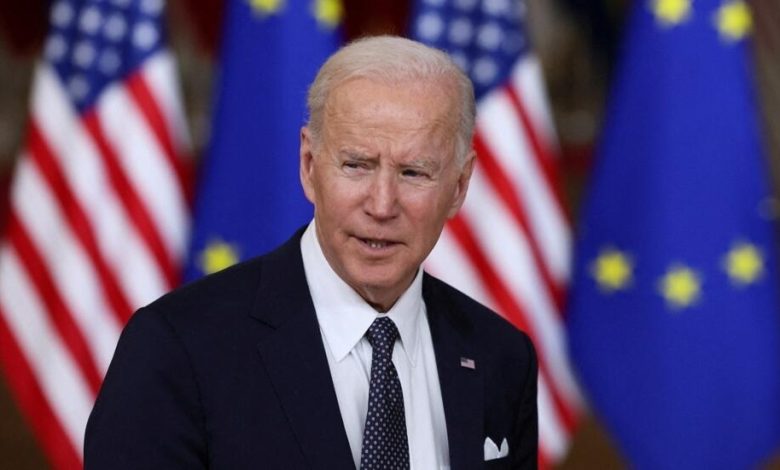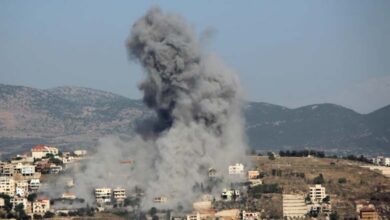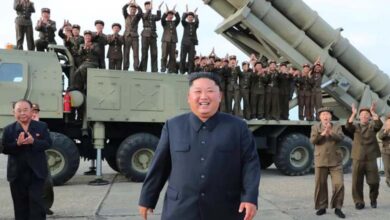Biden’s Policy Towards Ukraine: A March Toward “Disaster”

As the prospect of a peace agreement to end the Ukrainian crisis falters, and amidst the ongoing bleeding of Kyiv on the fronts, America has agreed to use its weapons to strike Russian targets.
The decision, which came months after French President Emmanuel Macron publicly floated the idea of NATO forces joining the fight in Ukraine, was warned against by the American newspaper “The National Interest,” saying it would increase the risk of escalation without meaningfully aiding Ukrainian capabilities.
General Charles Brown Jr., Chairman of the Joint Chiefs of Staff, acknowledged the inevitability of sending military trainers to expedite the process of preparing newly recruited Ukrainian forces for the front lines.
The statements of the American general and Macron‘s remarks push the war into uncharted territory, creating opportunities for significant escalation while contributing little to Ukraine’s ability to change facts on the battlefield, according to the American newspaper.
Will the 1920 Scenario Repeat?
“The National Interest” states that Biden‘s statement about using American equipment to strike targets in Russia near Kharkiv reveals the American policy dating back to the beginning of the Cold War. While American military aid was used to attack Soviet and Russian forces, it was never allowed to strike overt targets within Russia (except for the American intervention in the Russian Civil War from 1918 to 1920).
-
The World Gateway: How Did the Russo-Ukrainian Crisis Impact Navigational Passages in the Black Sea?
According to the American newspaper, Ukraine has already demonstrated its intentions to use its long-range munitions to strike targets related to Russia’s nuclear defense posture, such as the strategic nuclear bombers at Engels Air Base earlier in the war and the nuclear early warning radar just a few weeks ago. This creates a significant risk that Moscow may view this policy change as the first stage of a dangerous expansion of the conflict aimed at collapsing the Russian state and ousting Vladimir Putin.
It indicated that the potential presence of coalition trainers on the ground creates a different situation that is high-risk and low-efficiency, confirming that American, French, and other trainers would be exposed to deliberate or accidental strikes from Russia’s nationwide campaign of missile and drone strikes targeting Ukrainian infrastructure and military targets regularly—not to mention the direct risk from artillery, tanks, and infantry in Ukraine.
If these trainers are killed in an air raid, the victim country may choose to argue that the attack constitutes grounds for invoking Article 5 of NATO’s collective defense agreement.
While allied countries could choose to reject this claim, it would create a crisis within the alliance. This could either lead to the United States becoming directly involved in the war or cause a significant rift in Washington’s relationship with its allied countries.
Nevertheless, the risks involved in this move do not stop there; deploying trainers and advisors, often selected from special operations forces, near the front lines blurs the lines between training and direct combat engagement.
Dangerous Situation
In Ukraine, American trainers would not be mere passive observers; they actively participate in leading and directing local forces and may find themselves in combat scenarios.
The historical precedent of the American advisory and assistance mission in Vietnam suggests that the Biden administration is heading towards another scenario where these trainers’ mission contributes to a march towards full-scale war, meaning that the distinction between providing advice, assistance, and training will be unclear.
Rules of engagement allow trainers and advisors to engage in combat if attacked. This defensive stance, although necessary for self-protection, increases the likelihood of American soldiers becoming directly involved in combat with Russian forces, according to “The National Interest.”
-
“Priority Map”: New Ukrainian Army Commander’s plan to defeat Russia
-
Zelensky attacks Netanyahu and criticizes Israeli aid to Ukraine Ukrainian
Far-Reaching Consequences
The newspaper warned that the possibility of direct engagement with Russian forces, whether intentional or accidental, could have far-reaching consequences. “Escalating the conflict will not only endanger American personnel but also risk dragging the United States into a broader confrontation with Russia.”
The shifts in President Biden‘s policy create a situation where the administration will find it very difficult to control escalation in crises. President Biden promised the American people that he would not send troops to the ground in Ukraine, but unfortunately, his current policies are slowly pushing the United States towards violating those promises.












